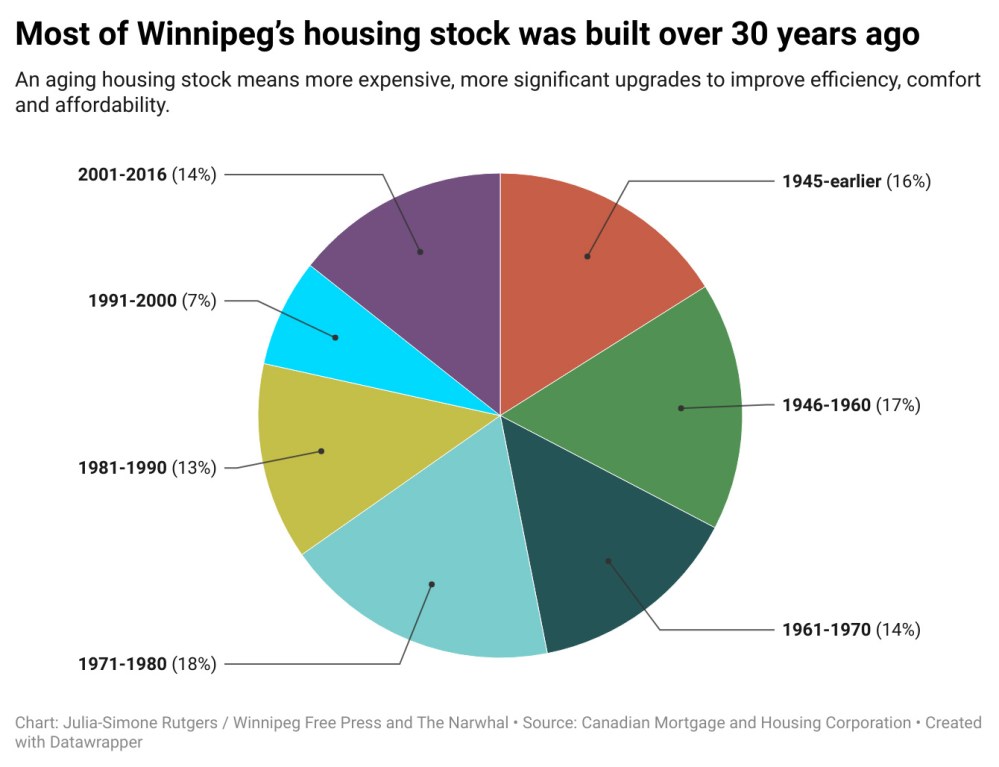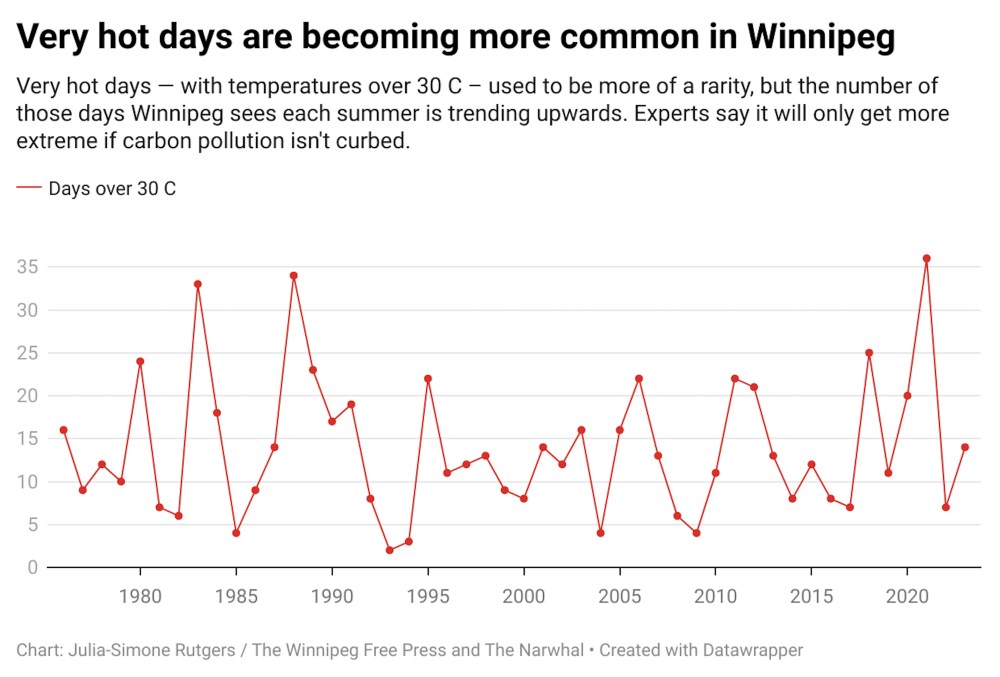Degrees of danger Rising temperatures have sparked calls for legislation to help keep Winnipeggers — especially seniors and the most vulnerable — cool and safe
Read this article for free:
or
Already have an account? Log in here »
To continue reading, please subscribe:
Monthly Digital Subscription
$1 per week for 24 weeks*
- Enjoy unlimited reading on winnipegfreepress.com
- Read the E-Edition, our digital replica newspaper
- Access News Break, our award-winning app
- Play interactive puzzles
*Billed as $4.00 plus GST every four weeks. After 24 weeks, price increases to the regular rate of $19.00 plus GST every four weeks. Offer available to new and qualified returning subscribers only. Cancel any time.
Monthly Digital Subscription
$4.75/week*
- Enjoy unlimited reading on winnipegfreepress.com
- Read the E-Edition, our digital replica newspaper
- Access News Break, our award-winning app
- Play interactive puzzles
*Billed as $19 plus GST every four weeks. Cancel any time.
To continue reading, please subscribe:
Add Free Press access to your Brandon Sun subscription for only an additional
$1 for the first 4 weeks*
*Your next subscription payment will increase by $1.00 and you will be charged $16.99 plus GST for four weeks. After four weeks, your payment will increase to $23.99 plus GST every four weeks.
Read unlimited articles for free today:
or
Already have an account? Log in here »
Hey there, time traveller!
This article was published 27/07/2023 (818 days ago), so information in it may no longer be current.
In June, Bethany Daman posted a free fan on her local Facebook giveaway page. She could never have anticipated the response from neighbours desperate to seek relief from the heat.
It was a sticky hot mid-June week — temperatures soared to over 30 C, hotter still in the treeless concrete tangle of downtown Winnipeg. Rural and northern communities across Manitoba were smashing decades-old temperature records. Across the city, residents flocked to spray pads, air-conditioned coffee shops and pools for a break from the swelter.
Daman was fairly comfortable. The 1958-built house she’d purchased two years ago has central air conditioning. When it seemed the heat wave wasn’t passing quickly, she decided to try to do her part by passing on an extra fan to someone in need.
Within hours of her Facebook post, Daman received dozens of responses from neighbours desperate for anything to mitigate the stress of extreme heat.
MIKAELA MACKENZIE / WINNIPEG FREE PRESS Bethany Daman, who works on climate advocacy in Manitoba, has seen the personal impacts of extreme heat this summer.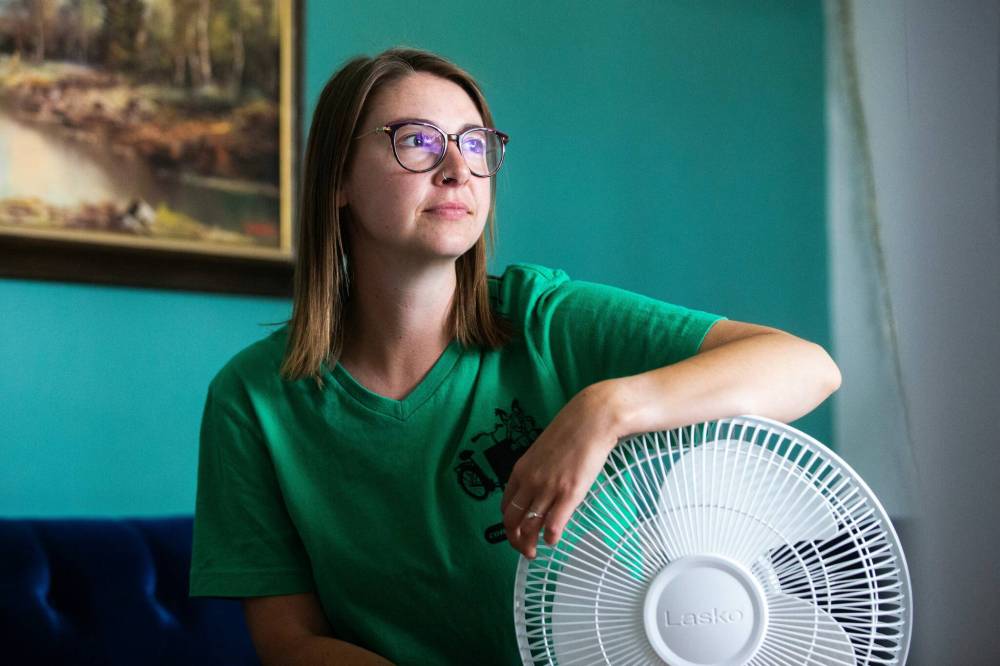
“The real heart-pulling piece was people talking about the need for their child to have a fan at night, or the teacher who said the air conditioning at her school had gone and wanted to take this single fan to cool her classroom,” Daman says. “But I just had one fan.”
Despite a reputation as one of Canada’s coldest cities, Winnipeg increasingly has a heat problem.
Old, inefficient buildings, a shrinking tree canopy and infrastructure geared at keeping the cold out and the heat in have combined to set a dangerous precedent as the city experiences new temperature peaks.
Like many Canadian cities, Winnipeg has legislation aimed at keeping residents warm in the coldest months, but there are no such laws to keep people cool.
As Manitobans suffer the health and financial impacts of new temperature extremes made worse by a warming climate, a chorus of citizens and policy experts are calling for system-wide adaptations — from residential heat legislation to home energy retrofits.
Heat a growing threat
The June heat wave was more than just a nuisance; Shared Health Manitoba, the provincial health authority, says 33 people in the Winnipeg area were admitted to hospital for heat-related illness between June 1 and July 4, nearly double the number admitted in the same time period last year.
To keep residents safe, the City of Winnipeg opened public hydration stations and encouraged residents to make their way to pools, spray pads, community centres and libraries to cool off.
Amid the uncomfortable heat, school divisions came under fire as buildings lacked proper ventilation or air conditioning and community groups called on governments to provide more support for unsheltered residents often left with few options to escape the scorching weather.
Health experts warned of the risks of extreme heat: heat stroke can be fatal, while other heat illnesses can cause rashes, exhaustion, cramping and fainting.
MIKAELA MACKENZIE / WINNIPEG FREE PRESS A new hydration station, which provides clean drinking water during the summer months, at Central Park.
These effects are more likely to impact vulnerable groups including infants and young children, people with chronic illnesses or physical impairments, newcomers, socially disadvantaged communities (like those who are low-income, unsheltered or living alone) and, most of all, older adults.
“Overwhelmingly, the people who are most affected by heat — and cold for that matter — are seniors, and about 95 per cent of Canadian seniors live in their own homes,” says Laura Tamblyn Watts, president and CEO of national seniors’ advocacy organization CanAge.
Watts explains older adults are not able to regulate heat as well as younger people, making them more vulnerable to hot temperatures. But it’s not just immediate impacts — experts note extreme heat makes existing cardiovascular and respiratory illnesses more severe, while cognitive impairments like dementia can make it more challenging for people to recognize the impacts of heat on the body. Those with mobility issues may not be able to access cooling centres or air-conditioned lobbies.
“It actually isn’t just a risk of immediate illness or death from heat — which is profound,” Watts says. “It’s that secondary risk in addition because they are going to have complications with other health issues.”
Canada is slow to collect and distribute data showing how hot weather impacts public health (Shared Health noted in an email to the Free Press that this information is not automatically or routinely tracked in Manitoba) but recent heat waves in the country have already proven deadly for older adults.
A British Columbia coroner’s report following a 2021 heat dome registered more than 600 heat-related fatalities. The majority of victims were over 70 years old, lived alone and did not have access to indoor cooling; nearly all deaths happened indoors.
Air conditioning and other cooling solutions aren’t “just a nice-to-have, they’re a must-have,” Watts says.
But Manitoba doesn’t mandate that seniors living in care homes have access to air conditioning, unlike in Ontario, nor that rooms be “safe and comfortable,” as in B.C. Nor do they mandate social housing — including seniors’ living complexes — provide air conditioning to tenants. That leaves many residents to swelter as their suites become “heat boxes” in the sun, Watts says.
“Older people are saying they’ve never been so hot, and there’s nowhere to go to cool down,” she says. “It didn’t use to get this hot, but with climate change being what it is, we’re getting heat that doesn’t go away.”
“It didn’t used to get this hot, but with climate change being what it is, we’re getting heat that doesn’t go away.”–Laura Tamblyn Watts, CanAge
According to the Climate Atlas of Canada, Winnipeg averaged 14 very hot days — above 30 C — each year between 1976 and 2005. There have already been 15 this summer. Over the last five years, Winnipeg has averaged approximately 20 very hot days annually, and the Climate Atlas projects the average will continue rising — to 30 very hot days a year by mid-century.
Experts agree: more hot weather will bring more heat-related deaths and illnesses. A report from the Canadian Climate Institute predicts a 21 per cent increase in heat-related hospitalizations by 2050, along with an additional 400 heat-related deaths per year. By the end of the century, the report suggests Canada could see an additional 800 deaths annually and a 102 per cent increase in hospitalizations unless carbon pollution is curbed.
How legislation can help
With the impacts of extreme heat most deadly indoors, advocacy groups across Canada have been asking governments to make cooling a matter of law.
In nearly every jurisdiction in Canada, landlords — including public housing authorities — are mandated to maintain indoor temperatures around 20 C in the winter. Winnipeg’s neighbourhood livability bylaw mandates rental properties cannot dip below 21 C during the day and 18 C at night. No such laws exist to regulate residential heat.
Watts says she’s spoken to Manitoba seniors whose apartments register temperatures over 30 C; renters in the city’s older apartments experience the same. Short of buying a window air-conditioning unit or fan, there’s little tenants can do to keep their living space cool.
In a climate crisis, Watts says, “appropriate shelter has to mean living at a temperature that is not causing you harm.”
That’s why tenants’ advocates in Ontario and other provinces have been calling on provincial and municipal governments to implement maximum heat legislation as part of their livability laws. The Advocacy Centre for Tenants Ontario, Canadian Environmental Law Association and Low-Income Energy Network banded together last year to recommend legislation that would cap indoor temperatures at 26 C — the maximum safe indoor temperature before health risks increase drastically for vulnerable individuals.
Legislation would allow tenants to complain to residential tenancies branches or city bylaw officers if their apartments aren’t at a livable temperature, and force landlords to provide cooling or face fines or other penalties.
So far only Hamilton, Ont., has proposed such a bylaw change. No other city or province in Canada has made such legislation a priority.
In an emailed statement Kristin Cuma, a spokesperson for the City of Winnipeg — which sets its own livability standards — said the city “has not considered a change to bylaws for maximum heat for residential properties at this time.” The province, in an emailed statement, said it is “not responsible for setting guidelines.”
Affordability is vital
Even if residential cooling was a matter of law, experts acknowledge air conditioning is not a silver bullet. Conventional cooling units release a lot of waste heat, which can contribute to urban heat-island effects — a phenomenon that increases temperatures in areas with lots of built infrastructure like pavement and buildings — and most require a lot of power to run.
Daman, who works for Manitoba’s Climate Action Team, says it’s likely tenants themselves who would be responsible for the extra electricity costs of air conditioning.
“That energy becomes very unaffordable for the renter,” Daman says.
Watts has heard the same from seniors.
MIKAELA MACKENZIE / WINNIPEG FREE PRESS Bethany Daman, who works on climate advocacy in Manitoba, stresses individuals can’t be expected to tackle these crises alone.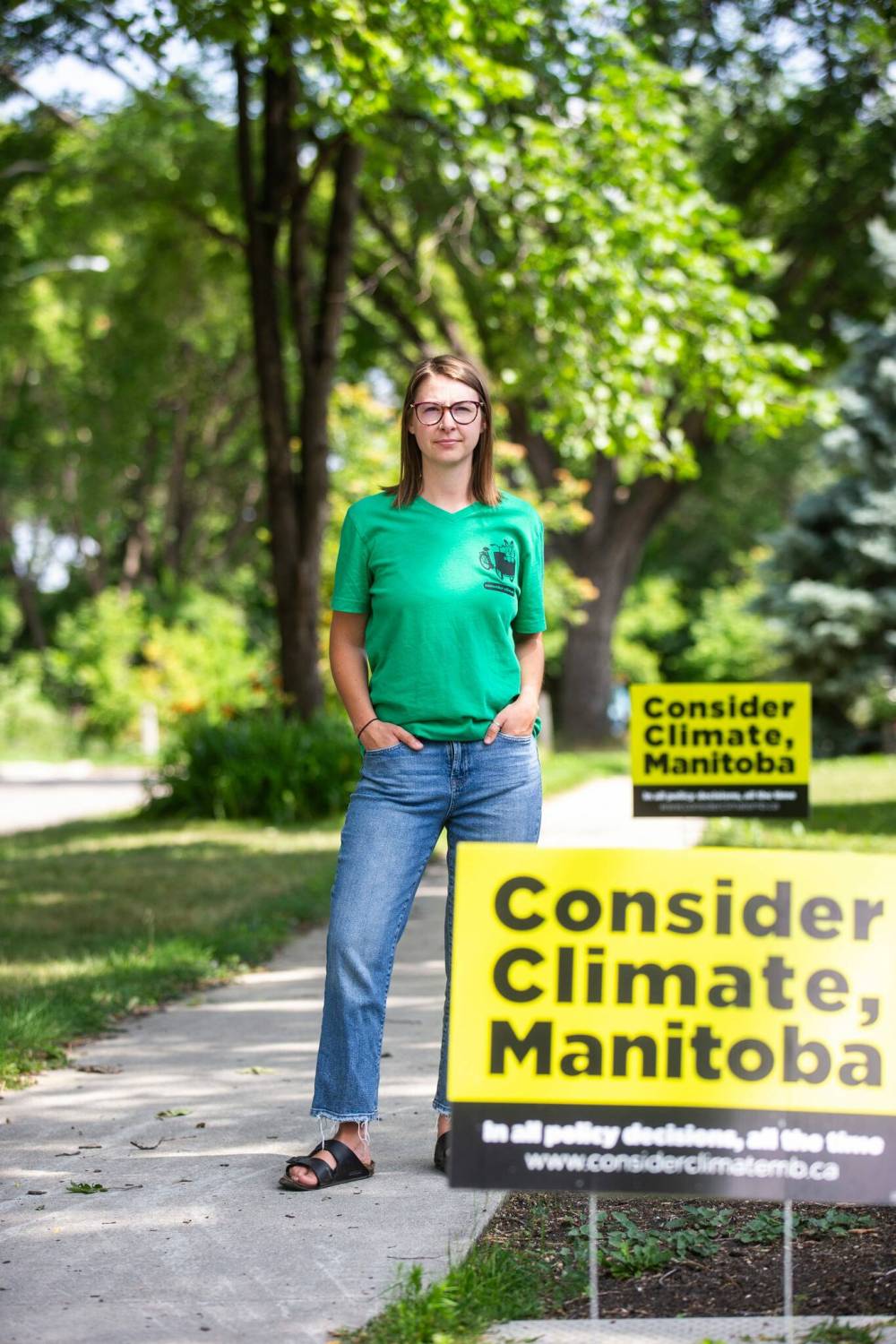
“We are hearing older people from Manitoba and across Canada saying the same thing: we have to make choices in the winter between heating and eating. Now we’re making choices in the summer between cooling and eating, or cooling and medications,” she says.
That’s part of why experts are looking to larger-scale adaptation strategies to curb the impact of hotter weather. Some of those strategies, at the community level, include heat-resilient urban planning, infrastructure and design, like green roofs (implemented in Port Coquitlam, B.C., Toronto, Montreal’s Rosemont neighbourhood and Gatineau, Que.); improving the tree canopy, which provides shade and cooling; and incentivizing passive cooling or other efficiency upgrades in residential buildings.
“There’s an extreme lack of understanding of how closely linked the affordability, health and climate crisis are,” Daman says. “People are siloing these issues without recognizing that increased heat means significant health consequences and lack of affordable energy means an affordability crisis.”
Individuals, Daman stresses, can’t be expected to tackle these crises alone.
“As an individual, the focus needs to be putting food on the table or making sure you’re healthy,” Daman says. “There are so many solutions that are possible, but at this point there are system- and policy-level recommendations that need to be implemented.”
One solution, recommended by Ontario’s tenants’ advocates and CanAge, is for governments to provide automatic credits or payments, akin to the federal grocery bill relief payments, that recognize the increased cost of cooling and give residents money-in-hand for relief.
But Daman says those payments aren’t a long-term solution. Instead, she says, governments should be incentivizing developers, homebuilders and current homeowners to improve residential energy efficiency.
Retrofits key to cooling
As Daman puts it: “the cheapest form of energy is conservation.”
Right now, Manitoba is looking to update its building and energy codes — currently from 2011 — to the higher-efficiency 2020 standards outlined by the federal government. Manitoba is mandated to make these updates by March 2024 (Manitoba is the only province still using the 2011 codes), but the government has already come under fire for choosing to adopt the lowest tier of residential energy improvements, which critics say is a step backwards, since most new builds already conform to a higher standard.
In any case, new builds represent just a fraction of Manitoba housing. According to federal statistics, nearly 80 per cent of occupied Winnipeg homes were built prior to 1990, and these buildings often can’t keep up with record-high temperatures.
Daman has been focusing her efforts on advocating for more incentives to help homeowners and landlords install residential energy-efficiency upgrades, acknowledging “individuals can’t be expected to finance retrofits.”
These upgrades can be small — more efficient doors and windows — or significant, such as replacing insulation or installing alternative energy systems like geothermal loops. Retrofits are unique to a home’s needs, and the benefits and costs associated are unique too.
“There’s an extreme lack of understanding of how closely linked the affordability, health and climate crisis are.”–Bethany Daman
The Pembina Institute estimates energy upgrades cost between $30,000 and $100,000 for a typical single-family home. Even though long-term savings generated by these retrofits can be significant (with some estimates suggesting up to 60 per cent reductions in energy costs) the up-front ticket price is out of reach for many Winnipeggers.
In Manitoba, where the energy for heating and cooling buildings represents about 20 per cent of carbon emissions (in Winnipeg that figure is much more stark, representing nearly 45 per cent of emissions), a Crown agency has been set up to help residents afford these energy improvements.
Efficiency Manitoba, implemented in 2020, provides rebates to residents who want to take action on home energy efficiency. The agency offers a wide range of programs aimed at reducing the cost of things like insulation, ground and air-source heat pumps, windows and energy-efficient appliances.
“We are here to help — there’s no catch and it’s not too good to be true,” Tracy Sterdan, a spokesperson for the agency, says.
MIKAELA MACKENZIE / WINNIPEG FREE PRESS Shared Health Manitoba reported that 33 people in Winnipeg area were admitted to hospital for heat-related illness between June 1 and July 4, nearly double the number admitted in the same period last year.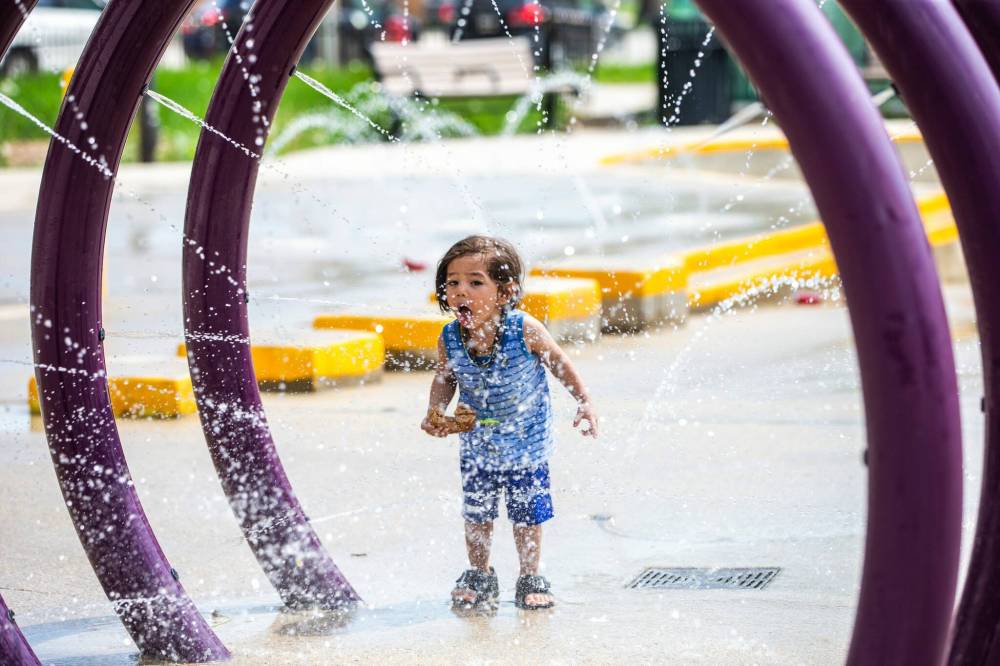
Technically, Efficiency Manitoba’s mandate is to help the province slash its natural gas and electricity consumption by 0.75 per cent and 1.5 per cent respectively each year, but Sterdan says slashing natural gas usage benefits everyone.
“Everybody likes to see lower energy bills, there’s reduced greenhouse gas emissions from reduced natural gas consumption and a lot of these programs provide increased comfort,” she explains.
So far, according to Sterdan, the incentive programs have been a success. More than 2,800 Manitobans have taken them up on window and door rebates, she says, and more than 6,500 have taken part in the insulation rebate programs. As for heat pumps, uptake has been lower — to the tune of about 70 participants — owing largely to the greater upfront cost of the retrofit.
Recognizing retrofits that require upfront payment can be out of reach for many Manitobans, Efficiency Manitoba offers an energy efficiency assistance program that tailors support to low-income households and provides several retrofits for free.
About 40 per cent of Manitobans qualify for this program and approximately 3,000 households have taken part so far, Sterdan says.
Recognizing human impacts
Policy changes like new bylaws, building codes and energy retrofit incentives take time to implement. Residents are experiencing the impact of extreme heat now.
At CanAge, Watts says there are practical solutions governments should implement to keep their most vulnerable residents safe.
“I think what’s going to be important for Manitoba is to move beyond joking about the cold winters and hot summers and the mosquitoes the size of airplanes, and move into realizing that it’s not the good old days,” she says. “With our climate emergency being what it is, a few degrees in either direction can be life or death for seniors.”
“With our climate emergency being what it is, a few degrees in either direction can be life or death for seniors.”–Laura Tamblyn Watts, CanAge
CanAge was asked to consult on Manitoba’s seniors’ strategy, where they advocated to see disaster plans for climate emergencies, including extreme heat and extreme cold. Disaster plans can include simple steps like wellness checks and buddy systems to ensure older residents are safe. They can also include regular checkups on residents in buildings known to lack air conditioning (the City of Winnipeg says it “does have a general awareness of which areas of the city and which buildings are less likely to have air conditioning,” though there is no comprehensive list available). Watts also recommends Manitoba comply with national standards to provide air-conditioned units for long-term care home residents.
Daman says she was inspired to advocate for system-wide change on energy efficiency and extreme heat because of “the human impact that this has” for all Manitobans.
“No matter where someone stands on efforts to reduce emissions, the impacts of these emissions are facing them,” she says.
Whether it’s needing a fan for their child to sleep at night, or to cool a classroom of kids, or to keep a parent or grandparent in good health, Daman believes system-wide action on heat should be a priority for Manitoba.
Watts is even more direct: “No one needs to die from the heat in their own apartment when we can take very easy steps in many cases to keep people healthy, hydrated and well.”
“No one needs to die from the heat in their own apartment when we can take very easy steps to keep people healthy.”–Laura Tamblyn Watts, CanAge
julia-simone.rutgers@freepress.mb.ca

Julia-Simone Rutgers is the Manitoba environment reporter for the Free Press and The Narwhal. She joined the Free Press in 2020, after completing a journalism degree at the University of King’s College in Halifax, and took on the environment beat in 2022. Read more about Julia-Simone.
Julia-Simone’s role is part of a partnership with The Narwhal, funded by the Winnipeg Foundation. Every piece of reporting Julia-Simone produces is reviewed by an editing team before it is posted online or published in print — part of the Free Press‘s tradition, since 1872, of producing reliable independent journalism. Read more about Free Press’s history and mandate, and learn how our newsroom operates.
Our newsroom depends on a growing audience of readers to power our journalism. If you are not a paid reader, please consider becoming a subscriber.
Our newsroom depends on its audience of readers to power our journalism. Thank you for your support.
History
Updated on Thursday, July 27, 2023 1:58 PM CDT: Updates headline and deck

